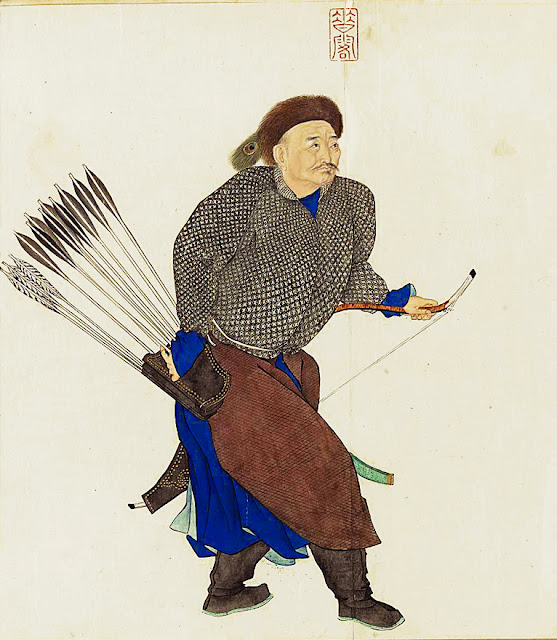Qing Dynasty Chain Shirts 清锁子甲
Duanjibu: a senior Manchu commander who fought in the decisive
Battle of Qurman (1758)- decked with with heavy chain shirt over gambeson
and armed with recurved composite bow and cavalry saber.
Ayusi: one of Qianlong Emperor's champion warriors, a master of spear
and marksmanship~ who was honored to be repeatedly painted by the Qianlong
Emperor's Italian court painter: Giuseppe Castiglione. Here he is depicted with
chain shirt, cavalry lance, recurved composite bow, and saber.
Machang: another one of Qianglong's key Bannermen Commanders who fought at Qurman
-decked, like most of his comrade commanders, with chain shirt, recurved comp- bow and saber.
Saral: Saral was probably one of the locals (i.e. Uyghur or Kyrgyz allies of the Qing
campaign) ~ distinguished by his fur cap. With chain shirt and gambeson, bow and saber.
Another painting depicting the chapion Ayusi: with campaign gears~ note the carbine slung
on his back, the weighed steel lance, and the massive size of the arrows he carried.
Ayusi again, (on the left) ^ demonstrating the efficiency of those long Manchu arrows. The Manchus~
When compared to the other steppe peoples~ always preferred long shafted arrows. Most were longer than an adult's torso. These arrows~ though harder to handle and more difficult to fire in a rapid sucession- are very stable in flight and are thus extremely accurate. -As illustrated by the fallen Uyghur warrior.
It was these bows~ when paired with massed Han musketeers- that ultimately conquered the Steppes and destroyed the various Mongol Khanates.
A nearly identical parallel to the Qing mailed shirt is the Japanese Kusari Armor, ~ which, interestingly, was influenced by the Mongol invader's chainmail in the 13th century~ so the Qing mail shirts and the Japanese Kusari may actually have had a common steppe ancestor.
Another detailed (and colored) view of the Qing chain shirt armor,
where one can almost see it acting as loose fitted clothing for the soldiers
Including collars and sleeves sewn on the fringes of the chain mesh.
During the Qianlong Emperor's western campaigns against the Dzungar
Khanate and the various Uyghur polities, many officers preferred these
light- fitting, and comfortable shirts over the bulky Brigandine.
Another detailed portrait of Ayusi, with closed up texture of the chain shirts as well. His belt secured his ceremonial sword concealed in a green shagreen sheath, his buffalo horn bow slung over his back along with a quiver of arrows with two types of fletching,
→ ☯ [Please support my work at Patreon] ☯ ←























Comments